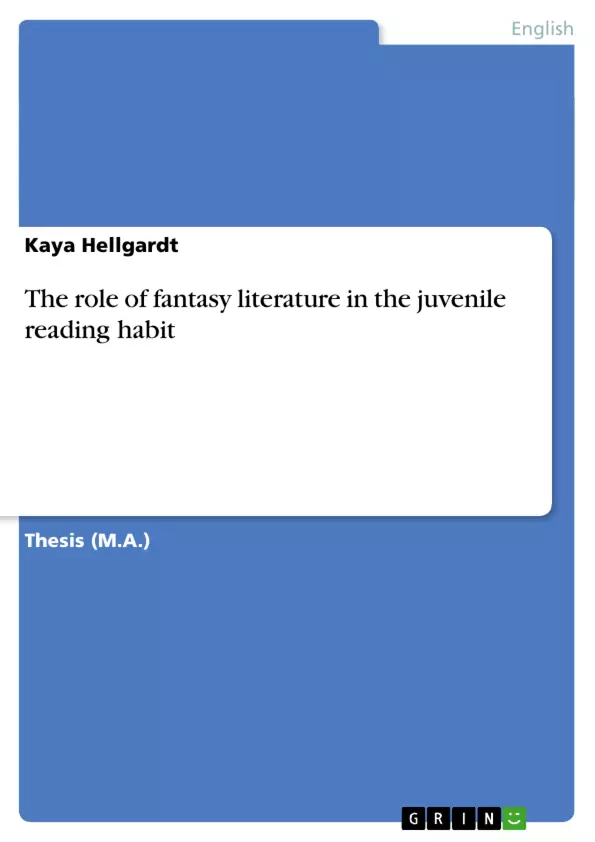A discussion of children’s literature as a topic of a research paper suggests the treatment of something new, a matter rather unexplored, or at least not as exhausted as most as-pects of the quite popular area of children’s literature tend to be with respect to student’s papers in English literature. ‘Something new’ would imply a book recently published, considering that a new publication is not likely to be exhausted by studies. This would also call for a discussion of the readership, as time changes very fast today and people change with time, so that children living around the turn of the millennium may ‘need’ and expect different things than children of the past. In fact, the present situation for children’s literature is a subject of particular concern, for technological development has influenced the matter of reading to a large extent and voices become audible that fear a decline of reading culture especially with reference to children and youths. This changed reading situation will be the starting point of my paper.
Inhaltsverzeichnis (Table of Contents)
- Introduction
- Children, Books and Reading Today – Literary, Psychological, and Sociological Aspects
- Children's Literature
- Defining Children's Literature
- A Synopsis of the History of Children's Literature
- Genres of Children's Literature
- Research in Children's Literature
- Child Development Theories
- Maslow's Theory of Human Needs
- Erikson's Theory of Psychosocial Development
- Piaget's Theory of Developmental Levels
- Kohlberg's Theory of Moral Development
- Children's Reading Needs and Reading Interests
- Reading Interests and Reading Preferences
- Reading Needs and Psychological Background
- Children and Reading Today
- Children's Literature
- Fantasy
- Defining Fantasy and Fantastic Literature
- Fantastic Matters
- Fantastic Journeys
- Good versus Evil
- Other Worlds
- Time Switching
- Visitors of the Unknown
- Miniature Societies
- The Function of Fantasy Literature, Aspects of Value
- Motives for the Success of Fantasy in the Contemporary Juvenile Readership - Construction of a Possible Concept
- An Analysis of Representative Pieces of Children's Fantasy
- J.R.R.Tolkien's The Lord of The Rings
- The Lord of the Rings - Contents
- The Lord of the Rings – Analysis in View of the Work's Popularity among Children
- The Lord of the Rings - Concept Applied
- J.K.Rowling's Harry Potter Series 1-4
- The Harry Potter Series - Contents
- Harry Potter and the Philosopher's Stone
- Harry Potter and the Chamber of Secrets
- Harry Potter and the Prisoner of Azkaban
- Harry Potter and the Goblet of Fire
- The Harry Potter Series - Analysis in View of the Work's Popularity among Children
- The Harry Potter Series - Concept Applied
- The Harry Potter Series - Contents
- J.R.R.Tolkien's The Lord of The Rings
Zielsetzung und Themenschwerpunkte (Objectives and Key Themes)
This paper aims to examine the role of fantasy literature in the reading habits of children in the beginning of the 21st century. It explores how contemporary authors address the needs and expectations of modern children and analyzes the potential therapeutic effects of fantasy on young readers.
- The changing landscape of children's reading habits in the context of technological advancements and the rise of electronic media.
- The enduring popularity of fantasy literature, particularly works like "The Lord of the Rings" and the "Harry Potter" series, among children.
- The potential reasons behind the success of fantasy in children's literature, including its ability to provide escapism, explore complex themes, and foster imagination.
- The application of a theoretical framework to analyze the influence of fantasy literature on young readers.
- The importance of considering both contemporary and historical fantasy works to understand their universal appeal.
Zusammenfassung der Kapitel (Chapter Summaries)
The paper begins with a discussion of children's reading habits in the context of evolving cultural, sociological, and psychological factors. It delves into the development of children's literature, defining the genre and its history, and examining various research methods used to study it.
Next, the paper examines relevant theories of child development, including those by Maslow, Erikson, Piaget, and Kohlberg. These theories provide a framework for understanding the needs and interests of children as readers.
The paper then delves into the realm of fantasy, defining the genre and exploring its various aspects. This includes discussions of fantastical journeys, good versus evil, other worlds, and time switching.
Chapter 4 focuses on constructing a concept to explain the popularity of fantasy in contemporary juvenile readership, exploring potential "therapeutic" effects that contribute to the trend's success.
Chapters 5.1 and 5.2 provide in-depth analyses of "The Lord of the Rings" and the "Harry Potter" series, respectively. These analyses examine the content, popularity, and influence of these works within the context of the fantasy genre.
Schlüsselwörter (Keywords)
This study explores the role of fantasy literature in the reading habits of contemporary children, focusing on the enduring popularity of works like "The Lord of the Rings" and the "Harry Potter" series. It examines the impact of evolving technology and media on reading culture, the therapeutic potential of fantasy, and the significance of understanding both historical and contemporary works to grasp the enduring appeal of this genre for young readers.
- Quote paper
- Kaya Hellgardt (Author), 2003, The role of fantasy literature in the juvenile reading habit, Munich, GRIN Verlag, https://www.grin.com/document/20185



